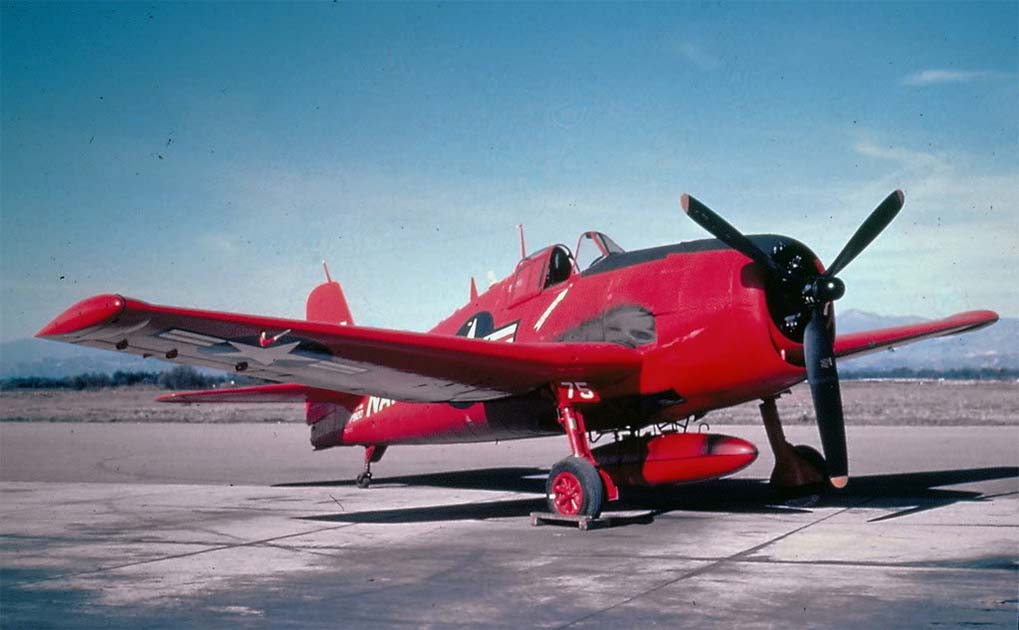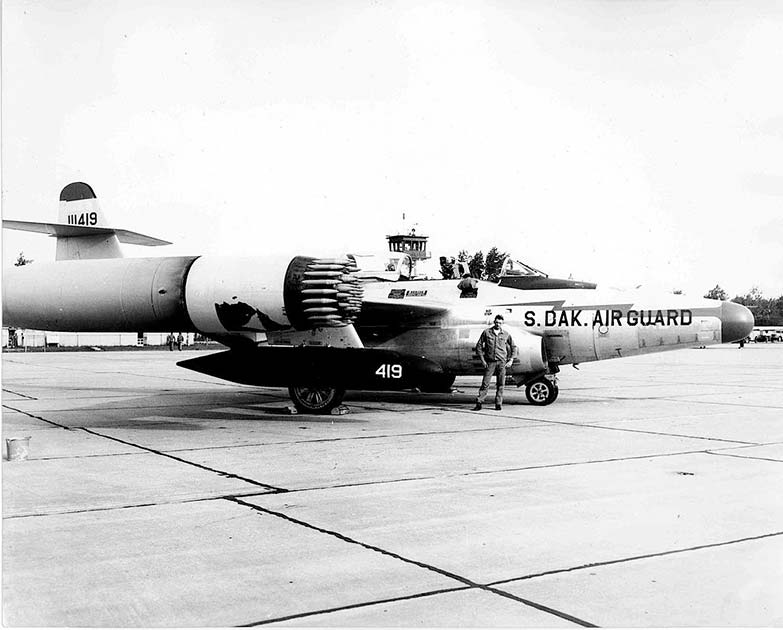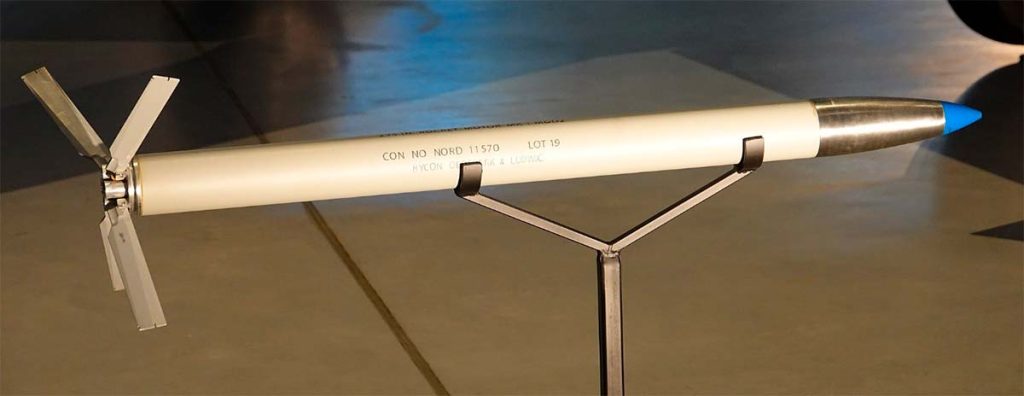Throughout the Cold War, the United States and the Soviet Union were engaged in one of history’s greatest-ever arms races. One significant aspect of this arms race in the 1950s was the breakneck development of surface-to-air and air-to-air missiles.
Both sides were spending billions developing fancy new ships and planes and the countries needed new, more advanced protection methods. As the race raged, corners were cut and technology that wasn’t quite ready was rushed out of R&D and into the field.
In 1956 this led to one of the most embarrassing incidents in US military history when two of the Air Force’s most advanced fighters failed to shoot down a runaway WW2 plane. Instead, they did a whole lot of damage on the ground.
Bombing Los Angeles
By 1956 the US was ahead of the Soviet Union when it came to missile tech. It was already testing several different missiles including the AIM-7 Sparrow and the Bendix AAM-N10 Eagle air-to-air missiles.
This put the US at least a year ahead of the Soviets but the problem was these missiles were innovative technology, deeply flawed, and needed extensive testing to iron out their numerous bugs. The US needed them to become operational, and quickly.

The final stage of testing them was to use them in live fire tests, meaning using them to shoot down real moving targets. To do this the military converted old WW2-era fighters, like the then obsolete Grumman F6F-5K Hellcat, into remote-controlled drones. One such test was carried out on 16 August 16, 1956. Suffice it to say it didn’t go to plan.
That morning a Hellcat drone, which was painted bright red for visibility, was launched from Naval Air Station Point Mugu in California. The plan was to fly the drone out over the Pacific Ocean where it would be shot down with the new missiles. Unfortunately for the military, the drone had other ideas.
Shortly after taking off at 11.34 am, the converted Hellcat began turning southeast towards Los Angeles. It had stopped responding to commands. The Navy, who were carrying out the test, had no available aircraft and called the Oxnard Air Force Base, just 5 miles (8 km) away for help.
The Air Force sent two F-89D Scorpions to intercept the rogue drone. At the time this seemed like overkill. The Scorpion was the Air Force’s new cutting-edge interceptor, blisteringly fast, heavily armed and jet-powered; it was more than capable of shooting down an old, unarmed WW2 prop plane.
Using their afterburners, the pilots of the Scorpions quickly caught up with the drone and then waited for it to fly over an unpopulated area so that they could open fire. They had 208 rockets between them, more than enough to take down a whole squadron of Hellcats should they need to.
Even better, the Scorpions were fitted with the fancy new Hughes E-6 fire-control system with AN/APG-40 radar and an attack-plotting computer. This meant that while the rockets themselves, the MK 4 “Mighty Mouse,” were unguided, the targeting computer would make shooting down the drone a cinch.

At least it should have done. Unfortunately, it turned out the system had a bug and after several attempts, the rockets failed to even fire. As the drone began circling back towards Los Angeles the pilots were forced to abandon their targeting computers and fire their rockets the old-fashioned way.
The pilots were experienced, and this shouldn’t have been a problem. But unfortunately, when the targeting computers had been installed the engineers had removed the old gun sights, meaning the pilots now had to blind fire the notoriously inaccurate Mighty Mouse missiles.
Still, the pilots had 208 rockets and only needed to hit the drone once to down it. The odds were still in their favor. The pilots set the rocket tubes to fire in “ripple fire” mode and prepared to fire an initial salvo of 42 rockets at the Hellcat.
As the drone flew over Castaic the first jet fired its salvo but missed the target entirely. Soon after the second plane did the same and landed several glancing blows against the drone’s lower fuselage. None of the rockets detonated.
As the plane closed in on the town of Newhall the increasingly worried pilots launched another 64 rockets. This time neither plane managed to score a hit. As the drone began to head toward Palmdale the pilots adjusted their intervalometer settings and made one final pass at the drone. Each plane fired its final 30 rockets at the drone. None found their mark.
Humiliatingly, two of the Air Force’s most advanced planes had fired 208 rockets at an unmanned, unarmed WW2 plane and failed to take it down. Low on fuel, the two Scorpion pilots headed back to base, and the drone carried on.
At least it did for a while. The drone, running out of fuel, eventually crashed into some desolate desert 8 miles (13 km) away from Palmdale Airport. It was a spectacular crash, and on the way down the drone took down three electric cables and hit the sand cartwheeled along the desert floor before completely disintegrating. Archaeologists were still finding bits of it in 1997.
The Aftermath
From there, things only got worse. The rockets had been fitted with point-detonating warheads which armed upon being fired. If they hit the target they exploded, if they missed, they were meant to disarm as their speed decreased.
But of the 208 rockets fired only 15 were found undetonated. All of the remaining 193 had exploded upon hitting the ground. Its reliance on state-of-the-art technology had let the military down once again.
- The Great Emu War of 1932: How did Australia Lose a War to Emus?
- Itavia Flight 870: did NATO shoot down an Italian Passenger Plane?
The first rockets fired by the pilots had started brush fires near Castaic, torching 150 acres (60 hectares) of land near Bouquet Canyon. The second set of rockets had hit near the city of Newhall but thankfully missed the city itself, although one rocket set several fires near a local park.
The rest of the rockets from the second salvo set fire to oil sumps belonging to the Indian Oil Co., who were less than pleased. This started fires that got worryingly close to the nearby Bermite Powder explosives plant. Other rockets burned a further 350 acres (141 hectares) of bush around Mount Gleason.
It was the final set of rockets though that nearly caused tragedy. The pilots had fired these while facing Palmdale and many of the rockets struck the town, with residents later reporting damage to their homes from shrapnel. One rocket landed just in front of a car as it drove down the street, shredding its tires and peppering its body with fragments.

Elsewhere in town, two workers sat eating their lunch and watched on as the truck they’d just left burst into flames. Other rockets caused fires all over Santa Clarita and Palmdale.
When the smoke finally settled two days later (thanks in no small part to the work of 500 firefighters) more than 1,000 acres (404 hectares) of land had been burnt.
Luckily, property damage was minimal and somehow, there were no fatalities (just a few close calls). Nevertheless, it was a major embarrassment for the US military and a catastrophe for the local ecosystem.
The military had not only caused massive damage on American soil, but it had also effectively fired upon a heavily populated urban area. With all the money being funneled into R&D it had to explain both why the Hellcat’s controls had stopped responding and why the Scorpions’ fancy new targeting computers had completely failed. The rockets exploding when they shouldn’t have was just the icing on the cake.
Then there was the rather embarrassing question: Why were taxpayers paying for fighter jets that couldn’t even shoot down one obsolete WW2 prop plane? The Soviets must have been lapping it up, despite being supposedly a year behind the US.
Of course, the incident didn’t put an end to the arms race. The military went back to the drawing board and overhauled the fire control system, fixing the bugs. Missile technology continued to evolve and fail-safes were added to unmanned vehicles.
Today, it would be nearly impossible for a similar incident to happen again. Nearly.
Top Image: The Battle of Palmdale, or how to fire 208 rockets at a town by mistake: a F-86 Scorpion firing Mighty Mouse missiles. Source: US Air Force / Public Domain.